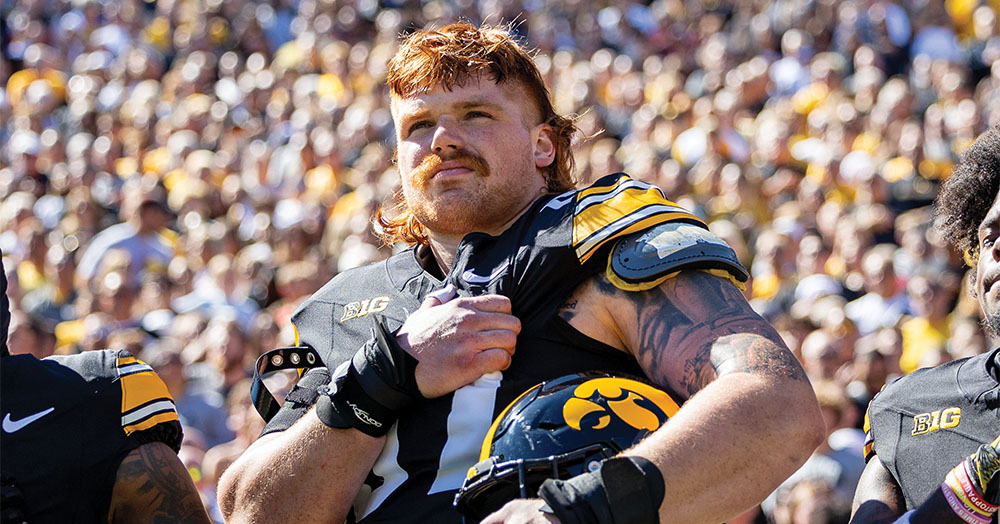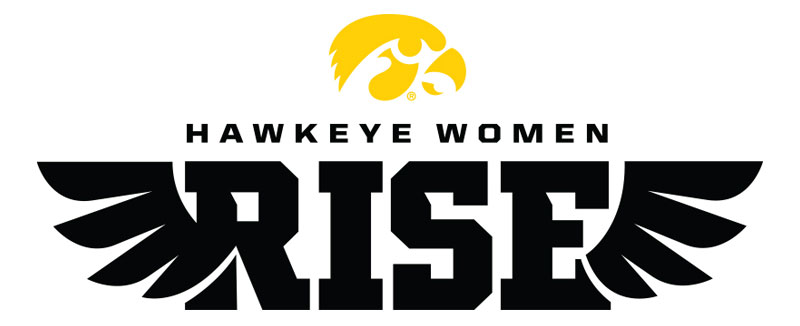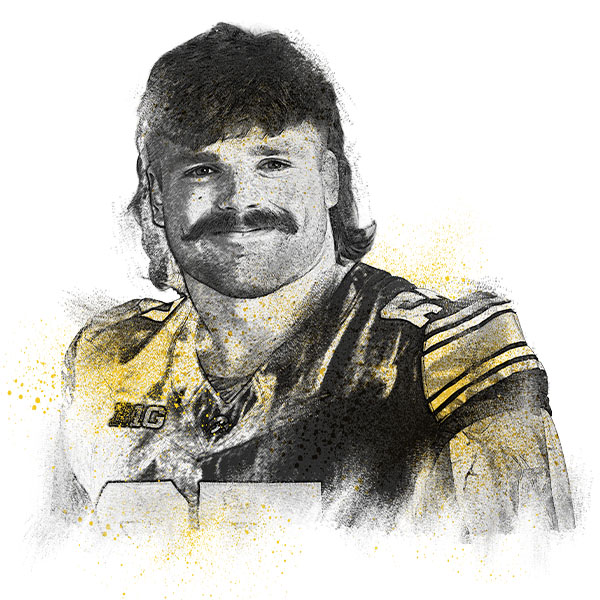How Hawks Like Gennings Dunker, Karina Muñoz Stay Fueled for Success
 PHOTOS: HAWKEYESPORTS.COM
A rigorous nutrition program helps Iowa offensive lineman Gennings Dunker consume enough calories to maintain his size and strength—and to get a competitive edge on the field.
PHOTOS: HAWKEYESPORTS.COM
A rigorous nutrition program helps Iowa offensive lineman Gennings Dunker consume enough calories to maintain his size and strength—and to get a competitive edge on the field.
After every Iowa football possession, offensive lineman Gennings Dunker hustles to the sideline and consumes about 350 calories of Honey Stinger energy waffles and fruit chews. The snack helps the 320-pounder continue moving opposing linemen against their will for 60 snaps a game. Meanwhile, Hawkeye gymnast Karina Muñoz has mere minutes to refuel with fruit snacks, pretzels, or Goldfish crackers between her four events in a dual competition. These easily digestible foods maintain her energy without tying her stomach in knots when she’s flipping through the air.
While every University of Iowa student-athlete has unique needs and preferences when it comes to fueling—and refueling—for success, the core nutrition principles are largely the same. Iowa Magazine talked with student-athletes and staff to learn how Hawkeyes fuel for peak performance.

Kira Blum
Director of UI Sports Nutrition
Performance Plate
Blum uses visuals to encourage student-athletes to fill their plates with whole grains, lean proteins, and fruits and vegetables. Heavier training days require more starchy carbs like bread, pasta, and potatoes, while light training days include a diet of less readily available carbs and more fiber from fruits and vegetables.
Fuel Sources
All Iowa student-athletes can grab nutrient-dense foods like smoothies, fruit, and protein bars at fueling stations in team locker rooms and practice facilities. They can also use the Black Card app, which has a preloaded amount of money for them to purchase meals at local restaurants that meet UI Sports Nutrition guidelines. Field hockey, football, gymnastics, soccer, volleyball, and men’s and women’s basketball can choose to provide catered meals in place of Black Card to their student-athletes.
Everything in Moderation
As a registered dietitian, Blum operates from a framework that everything can fit in an athlete’s diet in moderation. “I try to teach student-athletes to think about food in terms of what it’s providing you from a nutrient standpoint,” she says. And in a pinch, eating something is better than nothing.
Such was the case for the Iowa women’s basketball team in February when ice and flight delays before an away game in Minnesota limited after-midnight dinner options to Casey’s pizza near the Eastern Iowa Airport. “Should it be their main source of pregame fuel? Probably not every single game, but in the grand scheme of things, it offers quite a bit in terms of macronutrients,” says Blum, referring to the pizza’s carbs, proteins, and fats.

Raimond Braithwaite
Director of strength and conditioning for Iowa football
Weight Management
Target weights and caloric intake vary drastically by position. A first-year 175-pound defensive back may only have to gain 10-15 pounds and consume 3,500 calories a day to reach his ideal playing weight, while a first-year 285-pound lineman may need to add 30 or more pounds and consume up to 6,000 calories daily. During the most intense training phases, and especially in hot weather, every student-athlete is expected to finish between 90 ounces to a gallon of their electrolyte hydration drink each day. “Guys are extremely mindful, almost to a fault,” says Braithwaite. “They want to be lean because they’re athletes and get the job done with their bodies, but sometimes that can be a detriment if they’re overly restrictive with what they eat.”
Eat Often
Football players receive a catered breakfast and dinner most days. They’re also expected to eat a pre-morning workout snack, a pre-lunch snack, lunch, an afternoon snack, and a post-dinner snack. Braithwaite even conducts bag checks to ensure players always have a source of on-the-go fuel. “The weight room is just a stimulus for growth,” he says. “We stimulate your body for two hours, and then the true growth comes in what you do the other 22 hours—the way you eat, the way you sleep, and the way you recover.”
Supermarket Sweep
Hosting Nevada in 2022, the Hawkeyes faced lightning delays that extended the game to seven hours and forced Braithwaite to send equipment staff to the local Hy-Vee to get as many grab-and-go sandwiches as they could carry. “You might have a guy sitting in a corner eating an Italian hoagie and another guy eating a ham and cheese just to get through the evening,” he says. “Your options are limited. You try not to be picky.”

Ryan Ruckdaschel
Director of operations for Iowa gymnastics
Healthy Body Image
Nutritionists meet with the team before the season to share fueling strategies that promote optimal performance and recovery. The staff ensures food and snacks are readily available, though the gymnasts choose what, when, and how much they eat. Ruckdaschel, a former gymnast himself, emphasizes the importance of nutrition as eating disorders can be more prominent in the sport. “There’s no weigh-in and there’s no calorie count check,” he says. “It gets down to just the athlete themselves and how they feel.”
Meal Plan
At home meets, athletes receive their last meal about four hours before competition, smoothies for warm-up, and snacks throughout the meet. On the road, all snacks and meals are provided. Ruckdaschel coordinates meal orders and sends a menu to the athletes with Blum’s recommended selections. “Given the nature of the sport of judgment and perfection, there can be a negative rap with trying to look perfect,” says Ruckdaschel. “I think we’re in a place now where body types of all different kinds are proven to be successful in this sport. People are opening up to the idea that perfection looks different on everyone.”



